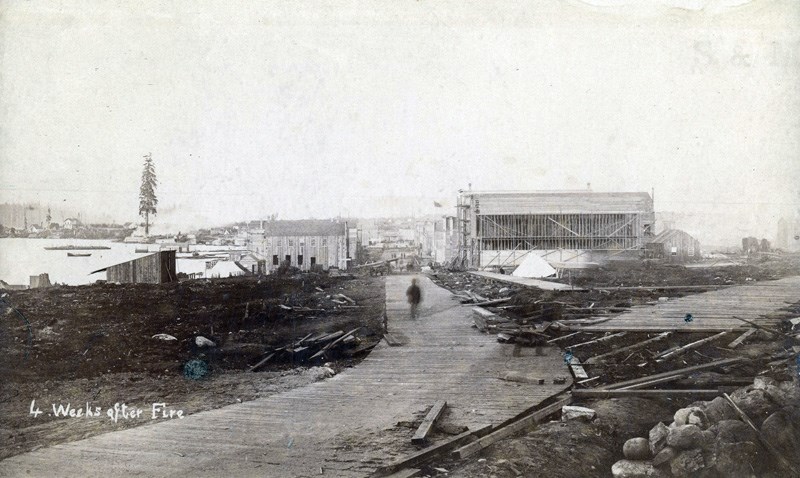As Vancouver burned, she paddled.
Taking off from the reserve she’d been forced into west of Lonsdale Quay, Agnes Lacket Joe piloted her canoe across the inlet.
“When the fire started they could see it right across the water,” noted Khelsilem, Lacket Joe’s great-great grandson.
As his great-great grandmother propelled her canoe forward, she sang a song of prayer for the safety of the people on the other side of the water, he said.
It was Sunday, June 13, 1886. Vancouver had been incorporated in April, the fire department had been established and equipped with axes and buckets 16 days earlier, but, as historian Chuck Davis put it, the city went from “creation to cremation.”
An 1886 painting depicts Vancouverites bobbing in the water and clinging to logs as the fire chews through houses, trees and churches. The warning bell atop St. James Anglican Church was reduced to a molten lump.
A newspaper account published four days later describes men ripping planks from a wharf and attempting to fashion crude rafts to escape the city.
Amidst the chaos, Squamish canoes raced to the shore, taking as many passengers as they could before turning around.
For 131 years that aspect of the 1886 fire has been unacknowledged. But on Wednesday, Vancouver Coun. Andrea Reimer called for the city to right a “shameful” omission.
“At the time, Vancouver existed because it had taken all of the First Nation families that lived here, literally herded them onto very small reserves,” Reimer said, her voice wavering with emotion during the council meeting.
Despite the traumas they’d experienced, they saved lives, Reimer said.
“People’s lives were saved because my people decided to, despite everything else that was going on with the government and the settlers moving into our territory,” Khelsilem agreed.
“I think it just showed the kindness and generosity of my ancestors.”
The Canadian Pacific Railway was clearing land when the fire got away from them, according to a volunteer fireman’s 1931 account.
While there were “a few score men” on guard with buckets filled with water, those men ran when a cool breeze turned into a gale that spread fire across the city in 40 minutes. The reported death toll has ranged from eight to 28. Many of the bodies were so badly burned as to be “barely recognizable as human remains,” according to a Daily News article of the day.
But not once in the article or in other accounts of the blaze is there a reference to the Squamish rescuers.
That absence is due to “extreme racism,” according to Reimer.
Acknowledging the heroic act is “an important step in reconciliation,” according to Vancouver Mayor Gregor Robertson, who suggested there may also be an opportunity for public art.
The fire was also a major part of North Shore history, according to Khelsilem.
“Some ended up settling on this side because most of their belongings had gone up in flames so they had to start over,” he said.
It’s important for cities and countries to make sure they tell untold stories like this one, said Khelsilem.
“For most of Canada’s history and for most of the City of Vancouver’s history, those in positions of power have generally been from one particular class,” Khelsilem said.
“When we get to times like these, there’s an opportunity for people with positions of power to uplift the other history.”
City council voted unanimously to thank the First Nations’ families who saved Vancouverites’ lives.



